Common Hogweed – Identification, Edibility, Distribution
Heracleum sphondylium, aka Cow Parsnip, Eltrot.
Heracleum persicum in the middle east, and heracleum maximum in N. America are closely related, and the seeds of these can be used in similar ways to those described below. I’d recommend conducting your own research around uses/safe handling of those particular species.
Common hogweed’s big brother Giant hogweed (Heracleum mantegazzianum, also occasionally known as Giant cow parsley, Giant cow parsnip and Hogsbane), which should not be handled or eaten, is also discussed at length below.
Common hogweed is a startlingly delicious vegetable and an amazingly versatile wild spice – my favourite of all edible wild plants in fact. But getting to know and safely eat it is not as straightforward as many other plants on this website. However, if you work your way though all the important considerations below and invest a little time getting to know this plant, I guarantee it will reward you many times over.
- Edibility – Be sure to read information on safe handling below. I do not recommend eating any part of common hogweed raw.
- Young shoots, green flower buds florets – cooked – 5/5 – the finest tasting vegetable (wild or cultivated) in the UK in my opinion!
- Seeds – 4/5 – pickled when green or used as a spice, especially when dried. More on these here.
- Mature leaves – 1/5 – Generally best avoided, but there is a history of fermenting them in E. European countries.
- Roots – 2/5 – great flavour, but very woody.
- Identification – 3/5 – one of the easier of the potentially deadly carrot family to ID, but caution still necessary as the tasty young shoots are not fully formed. Learn more about the carrot family and how to develop your ID skills in my Introduction to the Carrot Family for Foragers. And remember – we are talking about common hogweed (Heracleum sphondylium) here – not giant hogweed (Heracleum mantegazzianum), which should not be eaten or even handled – please read to the end of this post for detailed pictures of giant hogweed. Care should also be taken when handling common hogweed – see below.
- Distribution – 5/5 – Very common
- Season – March – September, seeds can persist on old umbels well into the following year, especially in sheltered locations.
- Habitat – Verges, hedgerows, field/wood edges, waste ground, rough fields and unkempt gardens. – particularly abundant around the coast, though not specifically a maritime plant
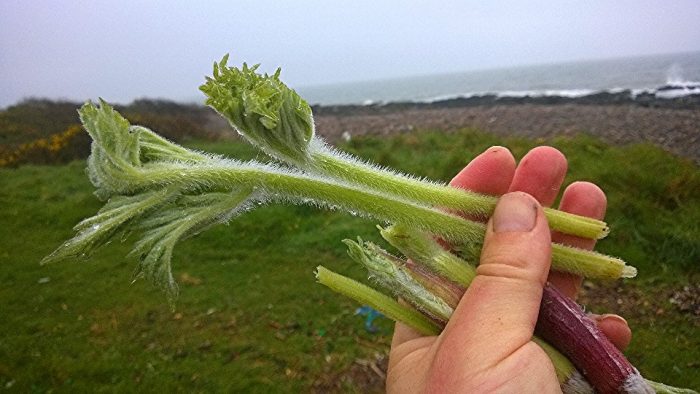
Common hogweed shoots at their prime edible stage – they tend to grow fatter and juicier near the sea
Hogweed is one of the most common members of the carrot family, becoming the dominant white flowered roadside umbellifer of summer and early autumn in most of the UK, after the cow parsley has dwindled and before wild angelica takes its place in the succession. As always, caution is recommended when picking members of the carrot family and you should base your identification on at least three distinguishable features. Look for:
- Leaves: Large, 3-5 lobes, hairy, serrated – though this will only be clear on fully grown leaves. New young shoots can often be found emerging at the base of mature leaves up until July.
- Stem: Hairy (but not spiny/spiky), grooved, hollow, striated, starting purple (not blotchy), becoming green, new joints and flower buds emerge from papery ‘parcels’. 1.5 to 2 metres (4.5 – 6 feet) tall fully grown.
- Flowers: White, often (but not always) with a pinkish hue, 5 petalled, 15-30 rays arranged in umbels of up to 30cm, but more usually 15 – 20cm. Petals on the outside of the umbel are usually larger. From a distance, I recognise common hogweed by the flattened tops of the umbels (relative to other umbellifers) – though this is insufficient for full identification. The flowers smell unpleasantly “farmyardy” – which may be where the name hogweed comes from, though it may also be because pigs would eat the foliage and roots.
Please see my notes and photographs at the end of this post for how to distinguish common hogweed from giant hogweed.
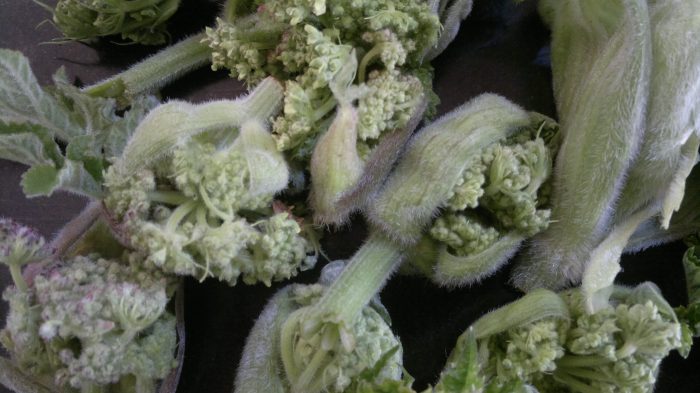
Hogweed flower buds at their edible stage – like soft heads of broccoli, squished up in natural parcels
As the best edible part comes generally before the other features, it can be challenging for common hogweed novices to feel comfortable with their identification during spring. This is a plant that demands, and rewards, some long term investment of your time: it is biennial (2 year growth cycle) or perennial, so if you spend a year observing it, the following year you will know where the shoots will emerge (near the base of the previous year’s skeletal stems), and feel much more comfortable harvesting and using them.
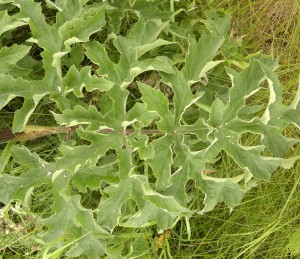
Fully grown common hogweed leaf. There can be some variation between plants in the sharpness of the lobes and divisions. Not recommended for eating at this stage, but young shoots can often still be found emerging alongside mature leaves
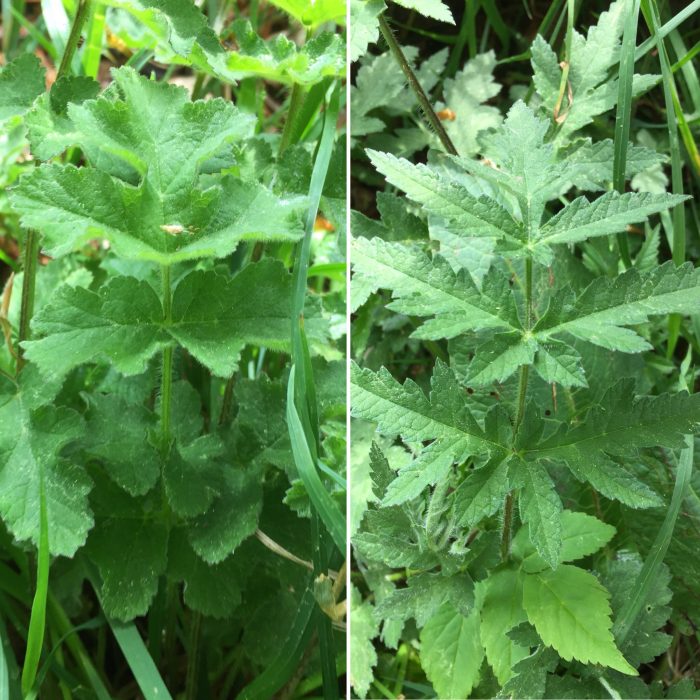
Two different phenotypes of common hogweed. In the same way that humans are all the same species but can look quite different, so too can some plants. These are both leaves of heracleum sphonyllium and were growing only metres apart.
Care should be taken when picking common hogweed as chemicals in the sap can cause phytophotodermititus – especially in strong sunlight. This can result in unpleasant and painful burns. I recommend wearing gloves if you are handling it on any but the most overcast of days.
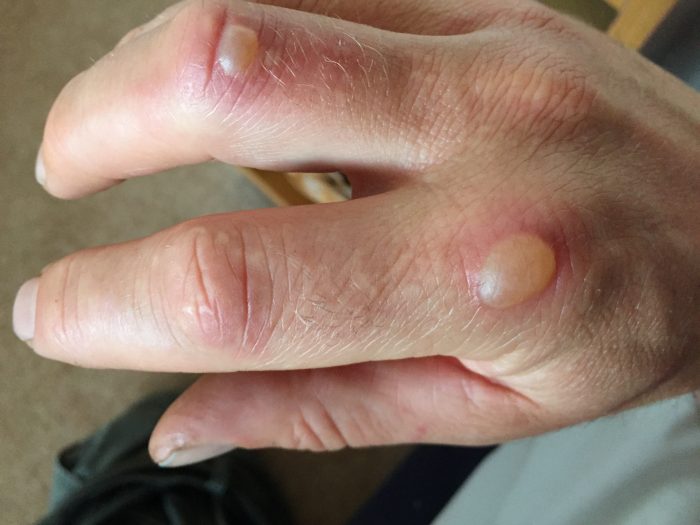
Typical phytophotodermititus blisters caused by common hogweed sap on a sunny June day. This was the first time I got a blister from picking it in 15 years of harvesting. But this probably says more about Scottish weather than the properties of the plant!
Children and people with sensitive skin or who are susceptible to sunburn should be extra careful. The sap is less of a problem when picking the young shoots and flower bud “parcels” (which are what you’re after) on overcast days in early spring, but you should remain aware and vigilant as the sap can persist on the skin. Washing it off before exposure to bright sunlight removes the threat – that is to say the burns result from the combination of the sap and direct sunlight.
During summer, as the plant matures, the sap becomes more phytopohototoxic, and sunlight more intense, and I restrict my handling to just snipping off seed umbels. Unfortunately instances of children getting burned after playing with common hogweed are not uncommon (the hollow stems make appealing pea shooters) – please educate them on potential dangers (see in the comments section below for further discussion of this, and read this excellent deep-dive into the chemistry of hogweed by my friend Monica Wilde if you want to know more.)
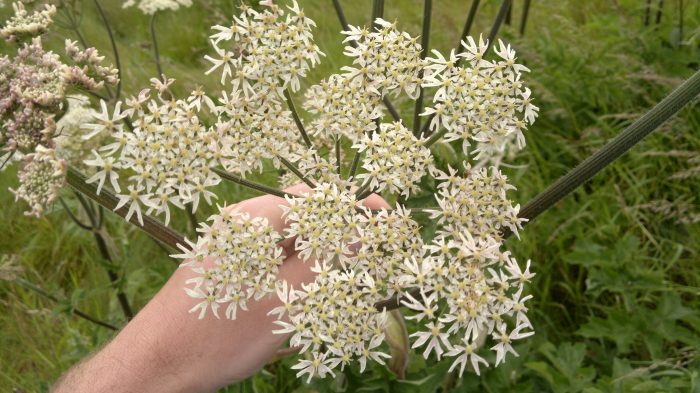
Common hogweed flower, July. Note the slightly larger petals around the outside of the umbelules. This feature is common but not always present on common hogweed.
So now you’ve read all of these warnings, you are probably wondering why you might bother?
Young hogweed shoots are one of my favourite wild vegetables, reminiscent of asparagus and parsley yet so much better – with a flavour all of their own. The roots will produce more shoots after harvesting and can provide a steady crop throughout spring and early summer. Rummage among the older leaves to find the “self-forced” shoots with long, fat, juicy stems. Fried in butter until the leaves start to crisp and brown, they are unsurpassed and best eaten as a stand alone vegetable. Stir through some sorrel leaves at the last minute to add some acidity to cut through the butter. They require little or no seasoning, having a rich and balanced flavour without help.
The unopened flower buds are also delicious and come in their own wee packages which means you can steam them without losing any of their sensational flavour – a glamourous steamed accompaniment to fish. Add them peeled to stir-fries, deep fry in tempura batter or to pickles. Older leaves are not so appealing, but make an excellent addition to a stock pot.
As if their sheer deliciousness isn’t enough, common hogweed is extremely good for you, being packed with minerals, and comparing favourably in lots of departments with other “super foods” – both wild and cultivated.
When the plant starts to die back for the year, you will still be able to harvest the disk-like seed pods (correctly known botanically as schizocarps) which have an extraordinary taste. I have heard them variously described as tasting of orange peel, cardamon, coriander, ginger, liquorice and burned cedar – probably a combination of all of those is a fair reflection.
There are two distinct stages to the seed pods: green and juicy when first formed, then quickly drying to papery disks
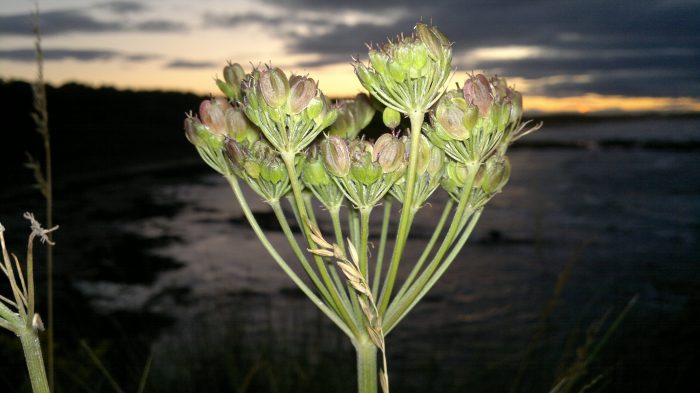
Common hogweed seeds – newly formed and green, with pungent bitter cardamon and orange peel flavours
They aren’t for everyone – a bit love-hate – polarising opinion about 70 (love) to 30 (hate) when people taste them on my walks, some people finding them unpleasantly “soapy”. If you do taste the green seeds raw, I recommend you take just a tiny nibble first time round. Some people experience a tingling sensation on the tongue. I have heard of one case of someone suffering an allergic reaction, but of the thousands of people who have tried them on my walks, nobody has had any problem.
Read more about the wild food, allergies, and the spectrum of edibility here
When still green the seed casings are pungently bitter so a little goes a long way. I add the whole green casings as “flavour bombs” in curry mixes, or pickle them and toss through salads with smoked eggs or pickled fish. Add them to pickling solutions for (eg) marsh samphire, rock samphire, sea aster, or reedmace hearts, perhaps with some other wild spices such as coriander grass. Try infusing them in hot butter then discard and use the butter like ghee in curries or for cooking fish or sautéing sea beet or other veg.
Green seed casings will dry out naturally on the plant, becoming papery disks which can be harvested from sheltered locations well into the winter. I harvest whole umbels then leave them to fully dry in a warm, airy room, before storing in bags. The seed casings drop off the umbels naturally in the bag. The flavour of dried seed casings (use the whole thing) is mellower, becoming more gingery and floral. The dry seeds of a very close relation to common hogweed, heracleum persicum, is widely used in Iranian cuisine, where the spice is known as golpar, and used in savoury dishes. As with many spices, dry toasting the seeds before use lifts the aromatics.
The dry seed casings can be ground and used in baking – try adding them to flapjack or they make a sublime parkin.
You can read more about hogweed spice and my fully adapted Hogweed Seed Parkin recipe here
The dry seeds also work extremely well in drinks and cocktails. Try infusing them into vermouths and gin, or adding them as a mulling spice to winter warmers.
I like the seeds best of all as a wayside nibble – just one really gets the taste buds partying – especially with a single sea buckthorn berry! Kapow! I add hogweed seed bitters to my wild whisky sour cocktails.
The roots of common hogweed have an intense aromatic quality, somewhere between angelica root and parsnips (both near relations) , with both deep earthy bass notes and bright herbaceous aromatics. They are generally too tough to use as a vegetable but are fantastic infused into aromatised wines and bitters and makes a great stand-alone schnapps. I’ve been trying for years to convince some of the distillers i’ve consulted for to use it instead of angelica root, to no avail!
Plants For A Future reports that you can obtain a natural sweetener from common hogweed by tying leaf stems together and he leaf stems and leaving them to dry in the sun until they turn yellow. A sweet substance resembling sugar forms on the dried stems.
How to distinguish Common Hogweed from Giant Hogweed
I am often asked how to tell common hogweed from its notorious big brother, giant hogweed (Heracleum mantegazzianum). Even when young, its eventual size is apparent by its huge sharply serrated leaves, spikey haired purple tinged leaf stems, giant flower umbel and stem “skeletons” (which usually persist from previous years), and its tendency to dominate all other ground cover.
Common hogweed by comparison, is quite a dainty wee thing, never more than 6 feet tall and rather less aggressive looking all round. As noted above, both should be handled with care – especially in bright sunlight, as their sap can photosensitive the skin, with potentially painful and alarming consequences.
But don’t let that put you off learning about them – your knowledge will, at worst, help keep you safe, and at best add a delicious, nutritious and abundant wild plant to your diet.
The photographs below are all of giant hogweed, showing some of its key features.
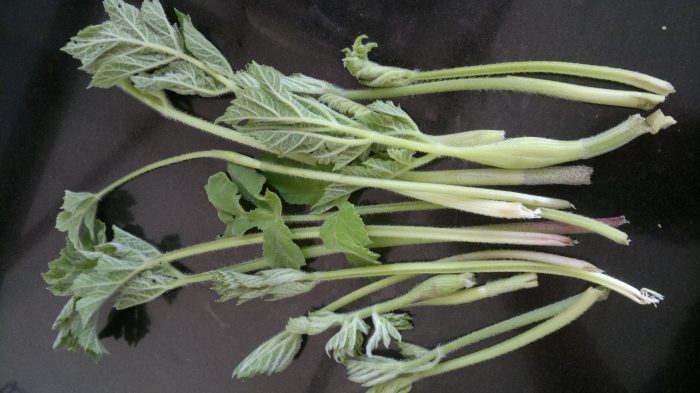
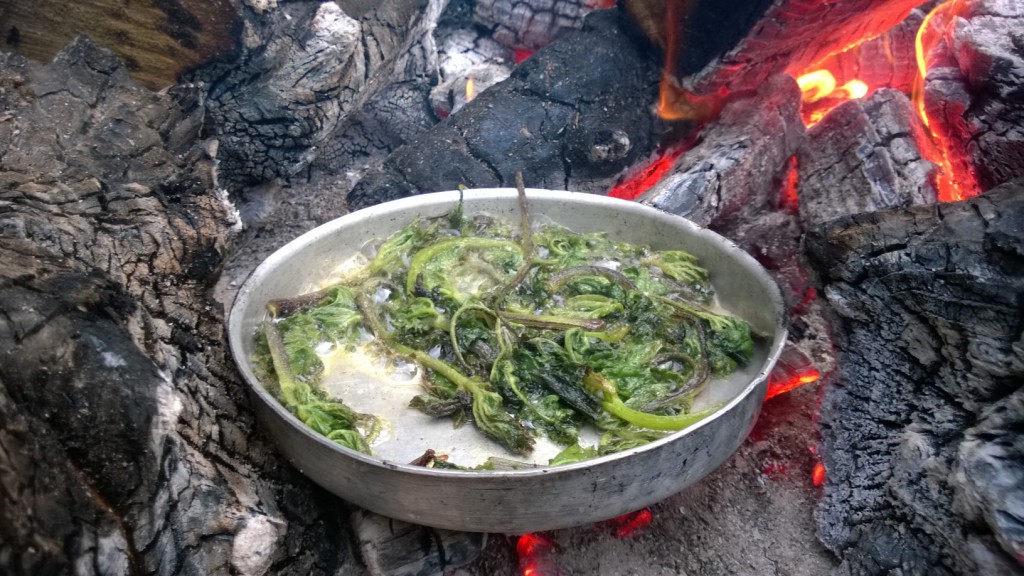
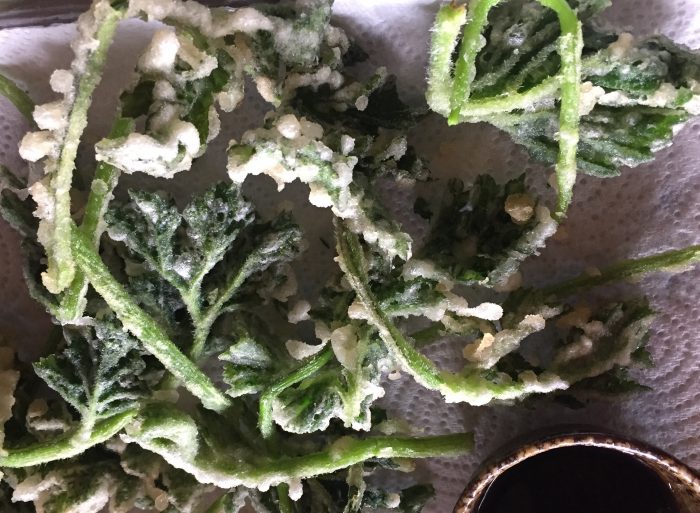


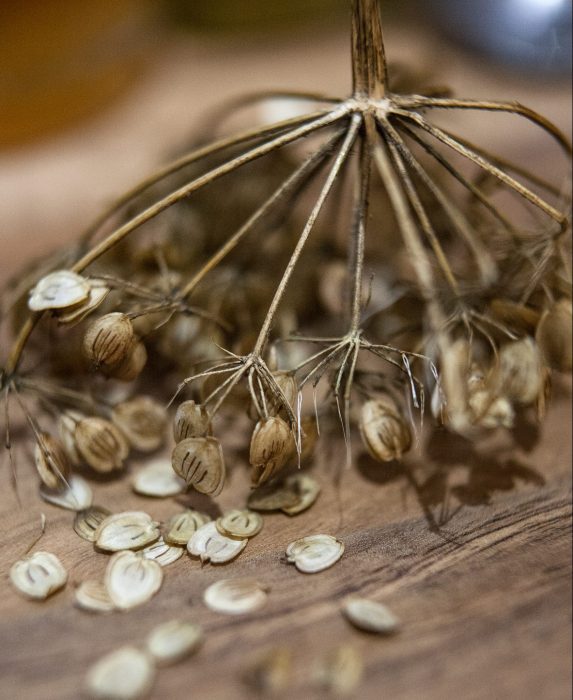
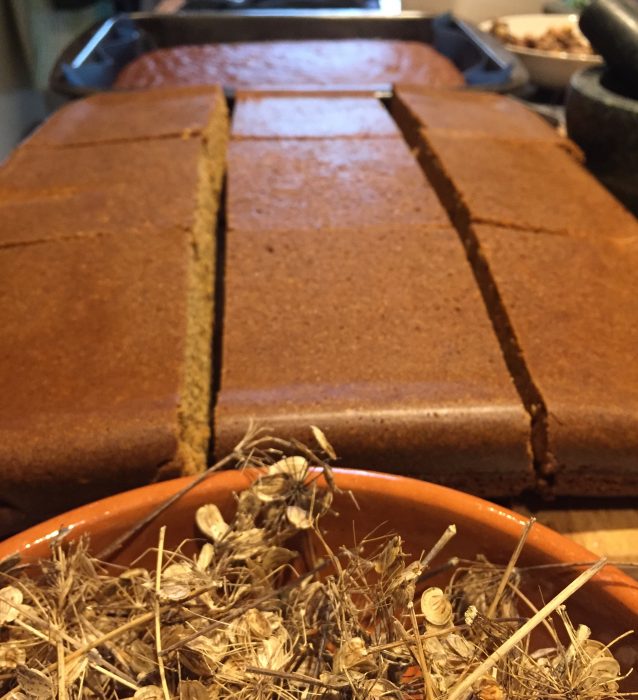
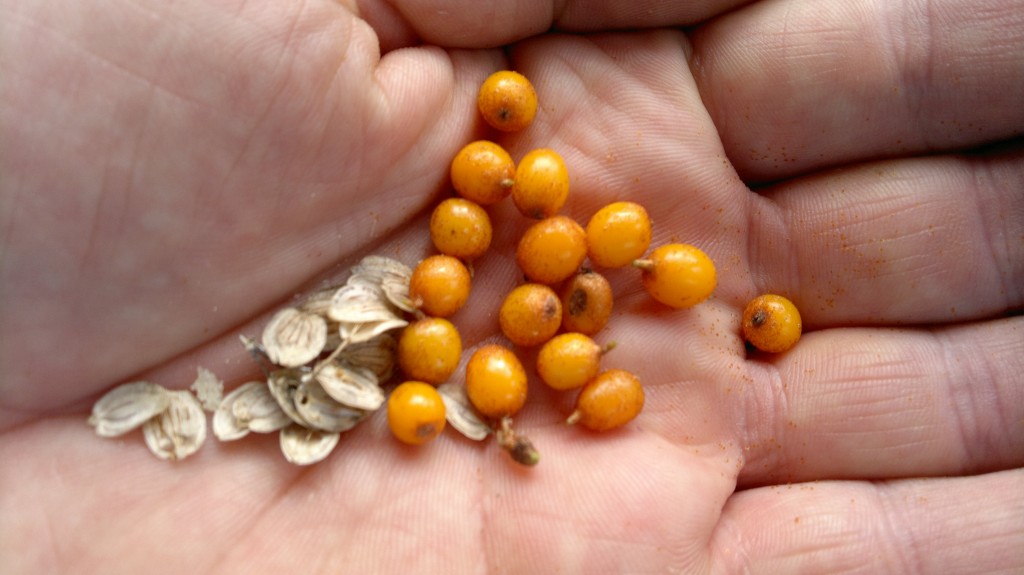
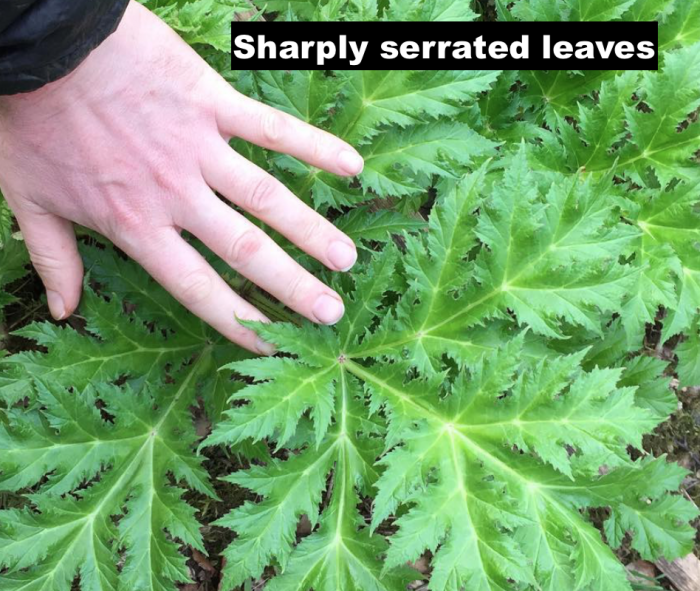
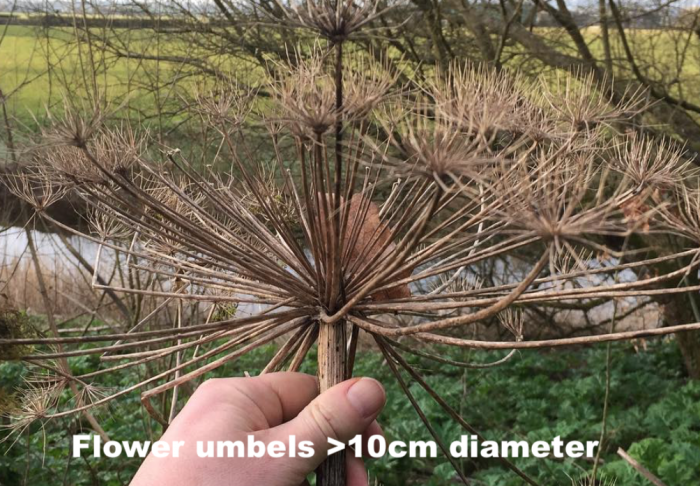
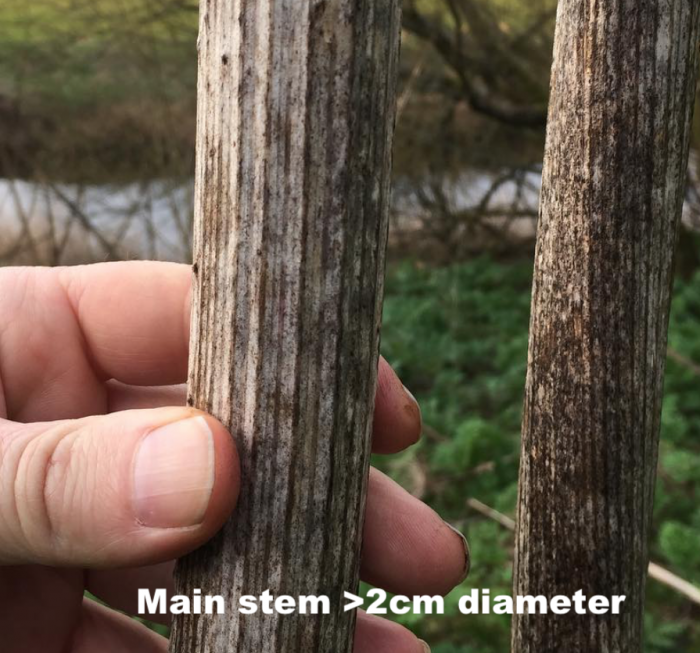
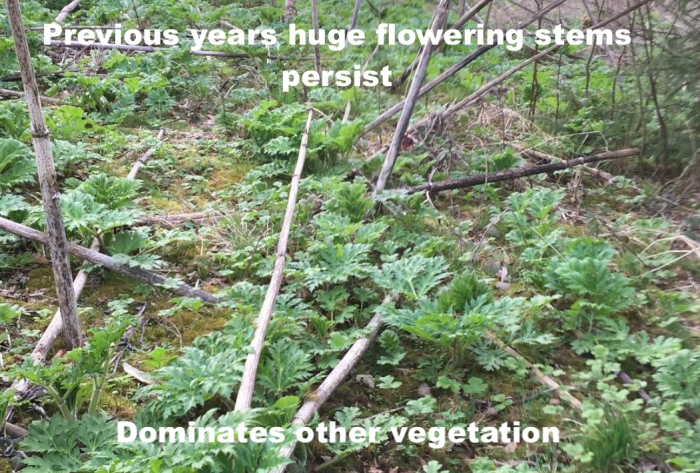
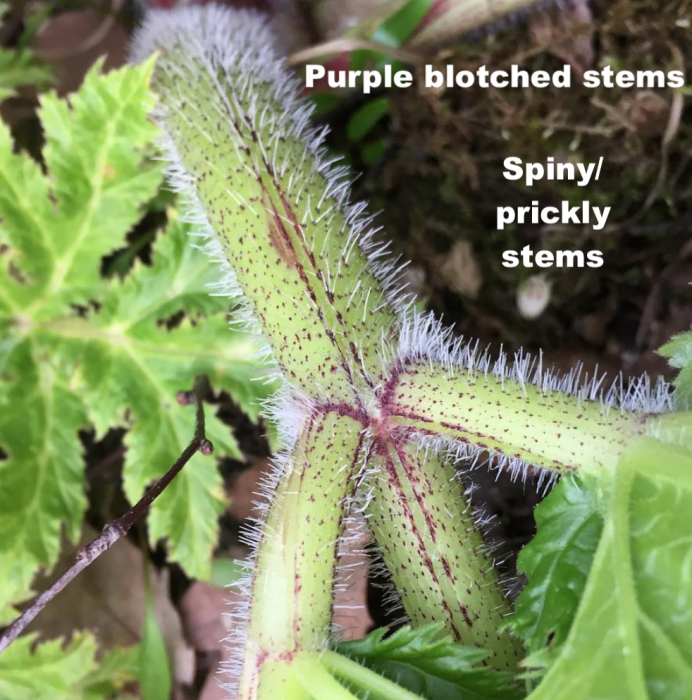

74 Comments
Dear Could you tell me where to buy common hogweed. I live in Belgium.
KR
Antoine M
Hi Antoine, I’m afraid I have no idea where you might buy hogweed in Belgium. It is very common in hedgerows in the UK and most people who know that it is good to eat, know it well enough to pick their own. You could try Miles at http://www.forager.org.uk/ – he supplies restaurants with wild food and may be able to help you out.
Best wishes,
Mark.
Hi, mark I have all the hogweed seeds dried but can’t find your recipe for the delightful Parkin on your website! Are you keeping it secret? Thanks sarah
Hi Sarah, Here it is: http://www.katherskitchen.co.uk/2012/11/hogweed-parkin/
Enjoy!
Hello,
Can anyone tell me where I could buy Wild Hazelnuts Seeds (Corylus avellana ( non cultivar)).
Many thanks, Meir.
Hi Meir,
I’d check out http://plantsandapples.co.uk/ first. If they don’t have, i’m sure they’ll know where to get.
Mark
Hi, I found two different plants that I believe are both hogweed but the leaves look so different to each other… Is this possible?!
Here they are:
http://www.projectnoah.org/spottings/428336004
http://www.projectnoah.org/spottings/425586007
Hi Jack,
Yes, I think both are hogweed (h. sphondyllium), but there are 8 subspecies of it, so you might have one of them. Also, plants of the same species can vary somewhat. A phenotype results from the expression of an organism’s genes as well as the influence of environmental factors and the interactions between the two. If you consider the variations in human phenotypes, no wonder there is some variation within plant species! There are some issues for the forager here of course – especially with species that already exhibit some irritant traits. I’ve had no trouble with any of the variants I meet in Galloway, but know a forager down south that has noted a high incidence of adverse reactions. Careful harvesting and consideration required!
Mark
My 11 yr old son is currently undergoing treatment with plastic surgeons for a severe 3rd degree plus toxic burn on his hand, believed to have been caused by contact with common hogweed. See phylophotodermatitis . We know of several other cases locally. It can take months to clear up, and the affected skin remains light sensitive and has to remain covered for 6/7 YEARS. My son realises how lucky he is when others have such a widespread area, but his is a very severe burn. He has to spend his summer after he leaves primary school with his hand fully bandaged, avoiding any contact with water, and no sports. For a county level tennis player and athletics team member this is not easy. Our self-catering holiday house with pool will be pretty tough. Be very careful what you touch, and perhaps reflect a little on what you advise others to touch. Burn mother.
Hi Nicola,
Thanks for your comment and i’m really sorry to hear about the injury to your son. I hope he make a full recovery and his sports and fun aren’t too adversely affected in years to come. I understand this must be distressing for him and you.
The level of burning he has suffered sounds closer to reports I have heard from giant hogweed after people have handled or strimmed it during the summer without adequate protection. But children have thinner and more sensitive skin and I have heard of issues with common hogweed too.
As mentioned in one of my comment replies above, there are several different strains of common hogweed throughout the UK and discussions with fellow foragers and botanists seems to show a higher incidence of adverse phytophotodermatitis in the South. This may reflect higher incidence of aggressively phytophototoxic strains as well as higher population densities and also higher levels of light intensity. The burning sap seems to develop in older specimens of all hogweed as they reach maturity and photosyththesise more intensively. This is the stage at which the foliage is of least interest to foragers but unfortunately when they are most appealing to children for making pea shooters, swords etc from the stems.
With regards to your final comment, yes, I am very careful of what I touch and what I eat, and advocate this approach to anyone interested in foraging. Education, information and knowledge are the best tools against misadventure by young and old. The shunning and vilification of plants is more likely to lead to misinformation and ignorance. I have talked about, harvested, cooked and eaten hogweed with school groups with no adverse consequences. They learned about a fascinating and very useful plant, and how to mindfully harvest it, play safely near it, cherish its uses and respect its potential dangers.
Without your advice to “reflect a little”, I already reflect deeply on the information I share on this website. You will notice several warnings on safe identification and handling if you read the beginning of this page. Again, ignorance leading to unfortunate incidents is sad and I hope by sharing sensible information this can be reduced. I hope your comment here will help increase people’s awareness of potential dangers, especially to children. I have just added an extra line with regard to children to the text too.
Finally, I am reminded of an incident from my youth. While picking mushrooms from a heathery banking, I suddenly noticed a lot of insects around my head. I had inadvertently stumbled on a bee hive. I was stung dozens of times. I am now very mindful of bees, but the incident sparked a fascination in me for their life cycle and usefulness in nature that has enriched my life ever since. I hope that this unpleasant experience for your son may inspire interest in, and respect for, plants, rather than fear and mistrust.
Wishing him a speedy recovery and many happy years of athletics, tennis, swimming and perhaps even a little botany…
Mark.
Good speech Mark. Poor lad! Some people have worse effects than others. I myself have many times wandered through stacks of Hogweed to no ill effects whatsoever. Also I’d like to say Human Beings have hurt and devastated Nature a million times more. If so many Humans had not gone away from nature we would know what to teach our children to keep them safe! It’s the same with anything.. Fire for example,,, Dangerous but extremely useful.
You have picked up on such a vital point Dean. How ignorant most folk are now of all things natural like being exposed to the natural world including dirt, bacteria, the elements and hard physical work from an early age. The world has grown soft and fearful. I’ve gardened all my life, never wash my hands whilst doig so but eat my sandwich and cake with filthy fingers. At 63 I’ve never had a stomach bug – good genetics maybe but definitely helped by bacterial ingestion that has boosted my immune system.
Dear Nicola
I was sorry to hear about your son and wish him a speedy recovery. I’d be very interested to know what part of the UK you were in when this happened. Also whether your son has ever had any food allergies or hay fever. I’ve been studying the seasonal and regional differences in hogweed and that info would help contribute towards a larger understanding. Many thanks
Monica Wilde
Researcher, Napiers the Herbalists.
I too have been “burned” by hogweed adjacent to the public highway in St. Clement, Cornwall. I had cut some to remove it from a well-used area, when the stem was blown across the side of my face and neck. I had lumps appear under my skin and burning and itching, which lasted 3 to 4 weeks, and itching and dryness continue to be uncomfortable.
I have informed the local council, and an officer has visited the area, which had not been maintained for over a year, I await some action. The hogweed had now seeded, so will continue to be a danger to the public in future years.
Hi Margaret,
Sorry to hear about this.
I’d be surprised if the council were to take responsibility for “controlling” common hogweed. Its hyper-abundant throughout the UK. What an odd precedent to start destroying all plants that could conceivably harm a human. Where would it stop? Buttercups? Nettles? Brambles? GM maize?
I think the answer must surely be in education. We have become distanced from the plants around us, and often lack the knowledge to keep ourselves (and our children) safe. In case you haven’t read it, I refer you to part of the answer I gave to a similar comment above:
“…Education, information and knowledge are the best tools against misadventure by young and old. The shunning and vilification of plants is more likely to lead to misinformation and ignorance. I have talked about, harvested, cooked and eaten hogweed with school groups with no adverse consequences. They learned about a fascinating and very useful plant, and how to mindfully harvest it, play safely near it, cherish its uses and respect its potential dangers.”
I hope your burn clears up OK and you use your hard-won knowledge to help educate others, rather than wage war on a plant that has many beneficial uses for humans and infinitely more for the natural world.
Mark.
I run a Forest School in West Sussex. Our grounds are covered in common hogweed in Spring through summer. No child has ever complained of any reaction to common hogweed, though I did find a blister on my hand the other day. I alerted the children to the danger. There were no complaints from them through the day. The blister/burn could have come from the hogweed. I’m not sure. There is definitely the possibility that individual plants are more toxic than others. I will let you know if there are any further incidences of phototoxicity here. Me, I have had my first taste just the other day–really enjoyed it! I also read on Plants for a Future that a sugar could be obtained from the stems. Have you ever tried it?
Hi, Ah, good to know you and the kids are switched on to this. No, I haven’t tried the sugar thing – but I will! This plant just gets better and better!
Mark.
Well said and true!
After my post last summer, I am very sorry not to have replied sooner. The seasonal appearance of common hogweed, and a friend’s query bring me back to this website. I am pleased to say that my son has not suffered any major damage or scarring following his severe burn after contact with hogweed. There appears to be no nerve or muscle damage in his fingers. He continues to have to wear a glove covering his hand at all times in daylight. This includes at school, sports, swimming et cetera, not easy for an 11 year old. We have had difficulty getting advice about how long he must keep this area covered.
For Monica Wilde: we live in Oxfordshire; he has mild hay fever, had mild excema; no known food allergies . I would be most interested in hearing more about your research.
I agree with Mark that education is the most important thing. My son was not specifically playing with or handling the hogweed. He just came into contact with it somehow in outdoor play in a rural area. Awareness is key. People need to know about this plant and the potential danger, then make decisions about handling it.
Nicola i hope that your son now is okey! Based on your information, about your’s son burns that couldn’t be Common Hogweed. It can cause burns, but not so serious to be covered for 7 years. That was 100% Giant Hogweed plant, they are similar, and 7 years sensitivity is result of Giant Hogweed burns.
Hi Monica
Here in Aberdeenshire we have a lot of Common Hogweed on our smallholding and I regularly collect it to feed to our horses who absolutely love it. I am usually wearing gloves when I collect it but also wear a t shirt and collect armfuls of it and have had no problems with burns, and neither have the horses. Our local variety’s leaves are like a very large, hairy Ground-elder with 3 lopes and virtually no serrations. Hope this helps your study, it is an impressive plant that councils are spraying indiscriminately in the belief that it is Giant Hogweed, I have had council workers on our small holding spraying where I had just planted some Willow whips; they did stop when asked, seemed shocked that we did not want it killing off.
Hi Monica
Here in Aberdeenshire we have a lot of Common Hogweed on our smallholding and I regularly collect it to feed to our horses who absolutely love it. I am usually wearing gloves when I collect it but also wear a t shirt and collect armfuls of it and have had no problems with burns, and neither have the horses. Our local variety’s leaves are like a very large, hairy Ground-elder with 3 lopes and with slight serrations. Hope this helps your study, it is an impressive plant that councils are spraying indiscriminately in the belief that it is Giant Hogweed, I have had council workers on our small holding spraying where I had just planted some Willow whips; they did stop when asked, seemed shocked that we did not want it killing off.
Thanks for the info Ralph, much appreciated.
Mark.
My 9 yr and 8 yr old son and daughter have had nasty blisters on their arms, tummy and leg after a camping trip in Malham (22-24/07/2014). They were making ‘boats/rafts’ out of grasses etc to race in the stream next to our tents and my son especially had used the stems from the plant that had a hollow, hairy stem and clusters of white flowers (which I now think may be Heracleum sphongylium). We had amazing sunshine for most of time we were there and little shade so used plenty of factor 50 suncream and wetsuits.
I used Compeed blister plasters on my daughter and covered my sons blisters with dressings as that was more comfortable for them (+Aloe vera gel). The blisters have burst now leaving reddish/brown itchy marks.
Neither my son or daughter have food allergies or hayfever.
We will be much more careful with what plants we use in the future!
Fui
Hi Fui,
Thanks for this information and sorry to hear about your children.
Its interesting to note that this happened in Yorkshire, quite far North in UK terms. (See comments/thoughts on this above).
Knowledge, often hard-won, both shields us from harm and opens new opportunities.
Best wishes,
Mark.
Hi Mark,
I am a horticulture part time student (back to it in September!) and gardener. I am very interested in the hogweed issues, and it’s that time of year again, with Giant Hogweed hitting the news today. Now then, Mum was gardening 2 weeks ago without gloves on…weeding…we live in Devon/Cornwall. A spectacular blistering rash developed on both palms necessitating medical attention. The rash has steadily worsened, spreading to chest, abdomen and thighs over the course of 4-10 days. Hogweed has been implicated but no proof. My question is this, can the phytophotosensitisation affect even those areas not contacted by the offending chemicals in the plant sap, effectively spreading? I wondered as this might lead to confusion in diagnosis?
Any info welcome,
Best Wishes,R
Hi Rachel,
Thanks for getting in touch.
As I understand it (and i’m far from being a scientist!), the sap acts on contact, so shouldn’t spread. This isn’t to say that your Mum hasn’t had a further reaction – like a celery allergy or similar. See Monica Wilde’s article above for more info.
I hope she is OK?
Mark.
is there anything toxic in giant hogweed seeds? think i might have just ate some…
I wouldn’t recommend them. I know some (experienced) foragers that have looked into food uses for them. Haven’t heard any positive reports. But they are all still alive!
My foraging teacher considers giant hogweed edible (but doesn’t recommend harvesting/eating). He was just reassuring me that in case I confused the two, it’s edible. But I don’t know his sources.
I was burnt all over my arms and legs 3 years ago by strimming common hog weed, im in stoke on trent, we on earth people say this horrible plant is safe to eat when it causes so much pain i will never know.Peolpe really need to understand just by touching this you can get burnt, as for eating it well, thats just silly. I still have problems going out in the sun now.
Your own fault for murdering the plants. Reminds me of my sister touching an electric fire! She was only 1-2. Learn something about what remains of nature before destroying it!
HAHAHA strimming we don’t use that word here, I had to google it, you mean trimming. Anyhow, the toxic reaction is UV dependent, and mediated by the same chemical that gives Earl Grey Tea its flavor, Bergamottin. Taken internally, you have no worries about sunlight. Recently read a British article about using black tea for sunburns and the ignorant author was all hoity-toi closing out the article with “…and i prefer earl grey tea”… well, upper crust twit of the year award goes to them! ANY OTHER plain black tea ok but Earl Grey tea contains the hogweed chemical and will make sunburns worse…
I have lots of giant hogweed on my property in Canada and have eaten small amounts in season without any photosensitizing. The seeds are delicious!
Thanks Brenda – that’s interesting. I’d be interested to hear more about your experiences eating giant hogweed.
The photosensitive nature of hogweed(s) is just one consideration. They tend to illicit a strong adverse reaction to anyone with a celery allergy (which are on the rise in Europe – see Monica Wilde’s excellent article on this linked above)
Here in Malham I have a large hogweed type plant growing beside the Pennine way footpath. Should I destroy it to avoid compensation litigation
or let it grow?
It has no hairs on it’s stem and the leaves are not spikey.
I tried to eradicate it two years ago and it has reappeared.
Hi Peter,
I think i’d be accurately identifying it first. If it is giant hogweed and its bordering the path, some remedial action may be sensible. There should be no issues with common hogweed – its a super-abundant plant and a war with it will never be won.
Hi Mark,
I had my first taste of common hogweed a couple of weeks ago – it was definitely an experience!! We steamed a flower bud, not quite opened, to see what it was like.
I thought the flower bud itself was a bit overpowering, and wasn’t to my taste, but I tried the very top bit of the stem which was amazing! A bit like asparagus 🙂 I was wondering, how big can the plants get before you’d avoid the stem? Or would you only ever eat it from the very young shoots (before they’ve got the flower bud)? The plant we picked was about 8 inches off the ground and about 1/4 inch wide…
Thanks
Laura
Hi Laura,
I’m glad you are exploring this amazing plant. I only eat the young shoots before their leaves have fully unfurled (as pictured above). This is for reasons of taste, and to avoid while the plant is photosynthesising more strongly, with associated higher level of fouranocoumarins that can cause adverse reactions. Similary, only the unfurled green flower buds, again, as pictured above. Height and width aren’t especially useful as much depends on just where the plant is growing. Some never get bigger than a foot or two, some very young shoots can be very fat. You just need to spend some time tuning in.
Cheers, Mark.
Thanks for this Mark. I have referred to your page many times whilst learning about hogweed. It has been a huge help.
I would like to point people towards a blog i just wrote with some additional photos which I hope might be of use to anyone trying to identify the plant. I was really worried about identifying hogweed and wanted to add additional resources for anyone in the same boat.
http://www.liamfltaylor.co.uk/april-hogweed-identification.html
Thanks Liam, some great detailed pictures there.
Your approach of actively seeking out scary species is a good one. Familiarity with giant hogweed, hemlock and hemlock water-dropwort keeps us safe and gives us confidence with the edible species – imagining a few less demons!
My guide to the the apiaceae family for foragers is here: http://www.gallowaywildfoods.com/category/beginners-guides/
What a wonderful website! I’m enjoying wild garlic, nettles, dandelions, wood sorrel swee cicily and more right now and for the first time tried common hogweed. Stupidly I relied on memory and ate it raw.
My experience of this was that it was utterly delicious, probably the most delicious plant I have eaten straight from the forest floor. However a mil tingle/irritation occurred on my tongue for an hour after. All gone now but having done further reading I see the advice is to cook it first. I have been collecting and eating wild foods for over a decade and cannot believe what a silly mistake I made by not double checking first.
A lesson learned, but not off-putting, it was truly a delight and I look forward to boiling some up :=)
Matt
Hi Mark
I’ve just come across your website whilst checking my identification of common hogweed. Fascinating stuff, thank you.
The reason I needed to identify it properly is that I have a small herd of dairy cows and they are currently grazing (browsing) some weed-filled river banks which, along with docks, nettles, creeping thistles, cleavers and some grasses (mainly cocksfoot) also has common hogweed (I now know it’s not giant hogweed!)
The cows absolutely love the hogweed. It’s mature, so 5′ – 6′ tall, and they go from plant to plant, pushing through the other vegetation to get to them. They them strip all the leaves and tops off each plant, leaving just some stalks a couple of feet long sticking out of the ground.
It’s great to watch and their enthusiasm is encouraging me to taste some too!
Hi Mark, thanks for the informative post. I have just picked (end July, Dunbar) some green seed pods from what seems to be the most abundant weed over here, common hogweed. I had a little taste raw and I can see that this is really powerful stuff whose flavour I could easily do more with. I am a little troubled by the bitterness so I plan to de-botterify them and then brine them like people do with caperberries in Greece where I am from. The flavour reminds me of raw caper buds in that you can taste the goodness but a bitterness kicks in and spoils it.
So the process I use with capers is soak the buds for 5-6 days changing the water regularly and then making a vinegary brine to put them in. Is there anything in this process that, in your opinion, might spoil the flavour or be dangerous?
Hi Giorgos, sounds like a great idea. I pickle mine in a basic 3:2:1 solution – 3 water: 2 vinegar: 1 sugar (I use a pre-infused strong sugar syrup for this 3rd element – often with wood avens root) – plus any aromatics I fancy. The sweetness tempers the bitterness, though I have to say, I quite like some bitterness in my “flavour-bombs”!
I’ve been eating a fair bit of hogweed the last couple of years ,it’s very moreish once you have a taste for it , I usually cook the leaves from the young stems until nearly crispy as well as eating the stalks ,I gave a small portion to a friend and she loved the taste but a while later felt that she developed a mild histamine reaction in her mouth and gullet, but it went when she ate some other food. I’ve never had any skin reaction personally.
I’m almost crying! I’ve been burning the seeds and new shoots in my allotment in an attempt to clear the hogweed!!!!! :, (
Dont cry. They abundance
Hi Mark,
Visited your website after hearing a talk about foraging on the Food Programme. Many years ago (1970?) I was a botany demonstrator at Newcastle when there was a widespread panic about Giant Hogweed which I saw growing in vast stands on river banks. There was a drive to clear it all out as children were tempted to use the 2″ wide stems as ‘telescopes’, with unfortunate serious consequences.
Later, while teaching in Somerset, we had an enquiry from the local Council about a boy with blisters on his arms. On visiting the site (a local viewpoint), the only likely Umbellifer I could find (the name changed to Apiaceae after I did botany) keyed out to Wild Parsnip. However, you mentioned Hogweed is rather variable so perhaps this could have been one of the subspecies.
This summer (June) I’ve been inspired to search a little more as whilst driving through a copse on a minor road (but a main route in rural Somerset) we passed a verge with abundant (normal) Hogweed plus one specimen of Giant Hogweed. The difference was striking: normal Hogweed was up to 5½ ft high but the Giant was easily 12ft, dwarfing my wife at just over 5 ft! Later (mid July), the Giant had been hacked down to the ground, so maybe somebody wasn’t taking any chances. There was also another, shorter specimen 50 or so yards away which seemed intermediate, and according to the source I’m using (Stace’s Flora of British Isles) hybrids do occur, mainly around SE Scotland and London area. I also see that the ‘seeds’ differ in that the Giant Hogweed has oil glands slight swollen at one end, while the outer ridge of the seed may be slightly hairy.
As you say, Mark, the answer is education, but sadly this has mostly fallen by the wayside, along with most people now living in towns. However, there is one simple principle to avoid problems when faced with ANY form of wildlife – treat it with respect and don’t tangle with it, especially if you don’t know much about it, but don’t injure it unnecessarily. Remember, whatever one comes across has as much right to be here as you and has had many millions of years to develop forms of protection: you don’t eat fresh Nettle or Foxglove leaves or Puffer Fish with impunity!
Best wishes,
Jim
Thanks Jim. Yes…knowledge and respect are the keys. Unfortunately ignorance and fear seem to all-to-often prevail…
Hi, I am researching Hogweed after mowing over some in my garden, unknowingly, and have come out in blisters all along my side a week later. I’m glad to learn of the edible qualities of common hogweed, which the plan that burned me seems to be, but am equally wary… I wasn’t wearing gloves when emptying my mower basket and must have rubbed my side. I’m based in West Cornwall. I am confused, is the vary same plant that caused my burn able to be harvested, or could it be a more violent, less edible subspecies? Does more burny = less eatie?! Thanks, Jemma
Hi Jemma,
If you carefully read this post and the thread above, it should shed light on most of your questions. In all cases their are a large number of variables in the plant (eg. stage of growth, phenotype, soil conditions, part touched), circumstances of exposure (e.g.. midsummer, noon, sunny day, length of exposure to sap etc) and the human encountering the hogweed (e.g. skin type, predisposition to sunburn, part of skin exposed etc). None of this makes the young shoots any less good to eat when cooked.
Mark.
Hi Mark,
Thanks for your very informative post. I’m a Persian food blogger. Ground hogweed seeds (heracleum persicum) is a very commonly used spice in our kitchens as well as in our traditional herbal medicine. We also pickle very young shoots and leaves. I’ve never had or heard of anyone in Iran having trouble with hogweed. Here in the UK (Berkshire) there’s hogweed everywhere but the plants are much smaller. Yesterday I picked some green seedheads and flowers and want to pickle them. I’m planning to write a blog post about hogweed’s culinary uses in Persian cuisine soon. I’ll put a link to your article for my British readers if it’s OK. By the way, I’m so glad I stumbled on your blog. It’s amazing! I’m a quite a good forager but don’t know as much about UK plants so it will be really useful for me.
Thanks Maryam. You are very welcome to share. Thanks for the extra insight into use in Persian food. 🙂
What’s it got to do with Hogs??
Pigs like to snout up the roots. Also, the flowers smell of pig poo!
Hi Mark,
Love your website. Just recently back from a trip to Fife where I happily munched on two of your recommendations, Sea Aster and Pepper Dulse, both of which were superb. I am thinking of making some ‘wild’ bitters (à la Angostura) and wondering if you have any suggestions for currently easily available wild herbs and spices?
I am going to start with Hogweed seed, Sea Buckthorn berries and Yarrow leaves infused in the strongest spirit I can find. Any other ideas?
Many thanks, Guy (in Lothian)
Thanks Guy. Lot of tips for bitters-making in my article on making foraged vermouth here: http://www.thebotanist.com/news/foraged-gin-cocktails/foraged-vermouth/
Have come to your website after someone I follow on Twitter retweeted your tweet about common hogweed.
I have been foraging for a few years now but not yet tried hogweed. I think I need someone more experienced than myself to show me the plant, so I definitely don’t confuse it with giant hogweed. However, I am intrigued!
I’m developing my own mini forest garden at home, where I am letting nature come in. No common hogweed has appeared yet but if it does, it sounds like a plant I should cherish.
Inspired by this page I went and foraged some hogweed florets and I have to say I was exceedingly disappointed… that I’d gone 32 years without ever eating them! Delicious! Found some green seeds that I enjoyed, but can see where the “soapy” label comes from (my wife didn’t like them). I have put them in some pickling vinegar to see what happens. How long would you recommend pickling them for?
Ha – glad you enjoyed them. I usually add the seeds to pickling solutions (ie. adding flavour to other things i’m pickling), rather than doing a whole load on their own. They should be good for months under vinegar.
Is Giant Hogweed known to be toxic in any way other than the obvious phototoxicity? It occurs to me that if common hogweed can be even mildly phototoxic but cooking renders it safe, then might the same apply to Giant Hogweed? If no information is available I do not intend to become the first to try it, I have always given it a wide berth and will continue to do so, don’t worry! Just academic curiosity.
Good question. General advice is avoid avoid avoid! …But this is based on the dangers of the sap, and also, no doubt, on fears around spreading the seeds. I’m not recommending it, but I did once nibble a giant hogweed seed. It wasn’t so different from a common hogweed seed, just a bit more pungent. This is something i’d probably do some practical research on (on myself!), but (gladly) giant hogweed is hard to come by in my area. The other difficulty is that where it does grow, it has often been sprayed with glyphosphates. I’ll ask around my colleagues in the Association of Foragers, see if anyone has explored this more deeply. 🙂
Thanks for the considered response Mark. Brave of you to have tried even just nibbling a seed, I’m not sure I would try that myself. We have a fair bit of giant hogweed around here (Aberdeenshire) and it has been spreading as nobody seems to be taking any responsibility for dealing with it. A few of us are talking about taking matters into our own hands, in the meantime I can be pretty sure it hasn’t been sprayed to date (this year at least) but I’m not prepared to volunteer my services as a guinea pig. It would be interesting to know how the plant is regarded within it’s natural range and whether there is a tradition of it ever having been put to any use, culinary or otherwise.
Just had this message from MJ, which seemed to get lost in my comments back end, but pasted in here as they are very interesting!), Mark
“I did some research on the subject last year, in the scientific literature. I wanted to know why you cannot eat it (like nettles that only sting when fresh). There is not a lot as you may imagine, although a lot more in edible plants with much lower concentrations of the toxic compounds (e.g., celery). In a nutshell, the type of coumarin that leads to phototoxicity (linear furanocoumarinsis, psolaren) is not destroyed by heat. Coumarin binds with RNA and DNA. In some conditions, ingestion will lead to liver damage, and the toxin can enter the bloodstream, and from there produce phototoxicity even if the plant was not touched (via the effect on cell dna). Concentration is highest in the green seeds. It is not clear how much you would need to ingest, but not that much I would think since some people have similar milder issues with edible plants. Some people are more subject to toxic effects. On the other hand, controlled doses are used in the treatment of skin conditions such as psoriasis, either in ointments or ingested. Hope that helps. Regards, MJ”
Can giant hogweed be not so giant. There’s an umbellifer growing near me which has big flower heads, the middle one is about 20 inches across, and some of the leaves are 2 feet long. It also has purple spots on the stem. But the plant itself is only 5ft high.
Yes. When cut back, both common and giant hogweed (and many other plants) have a remarkable ability to regrow to a shorter height and still produce flowering heads. Having said that, 5 ft tall, 2 ft leaves and 20 centimetre (but not 20 inch) flower heads sound more like the dimensions of common hogweed.
Thanks so much for all of that, Mark! And can I ask – you say don’t use any part of common hogweed raw. Do you include the seeds in that? I have some green ones I plan to pickle – will I have to cook them afterwards? I also have some papery seed cases that I’d like to toast and grind up to put in raw sweets. Would you have concerns with that?
Thanks!
Ah, right, yes. Sorry, not been clearer on that. I do use the green and the dry seeds uncooked with no issues. But best to be careful with the green seeds as they can definitely make tongues tingle. Mostly they are a bit much for use raw, so I tend to infuse them into the vinegar first any, by heating.
Hi Mark, I’ve been foraging on and off over the past 3 or 4 years now, so I’m beginning to look into the apiaceae family now, something which I’d avoided, given giant hogweed and hemlock. As such, I found your page, and you’ve definitely inspired me to try some hogweed. It’s very common here in the south of France; I haven’t seen any of its giant cousin.
I wonder if you’ve ever come across an Android app called pl@ntnet. It’s been an invaluable aid to me learning plants; basically you take a photo or 2 of a plant, upload it to their servers and it uses AI to identify the plant. It is generally very accurate, especially if you take 2 or 3 different photos, eg of a leaf, the stem, its habit. A great tool for the beginning forager.
Hi Simon, Thanks for this – i’m glad you are enjoying foraging and that my website is helping. I have written at length about the pros and cons of identification apps here: . Best wishes,
Mark.
common hogweed – yum – why is it – sometimes it tastes like sausages and sometimes like coconut
wanted to know what to do with so many flowers heads this year but little leaf? but then each year is different
found it interesting that during last year and year before with virus had big harvest of hawthorn and rose hip – helps circulation and gives vit c – good for coughs, colds and virus – and now with the third wave coming we have an excellent harvest of elderflower – again good for colds and flu
isn’t it amazing how nature gives us what we need – if we care to look
i love native food and medicine – nice website thank you
There must be a lot of regional variation of the toxicity of common hogweed. As a child I used their stems to make pea shooters and feed the leaves to my rabbits who loved them. I never had anything remotely like a blister or irritation. I just today have walked on a hogweed-infested public footpath in Berkshire, pushing them aside and breaking some of them off. None of us three in the party had any problems, even the palest of us.
Yes, there are both regional variations, and variations in phenotypes, as well as variables like stage of growth, cloud cover, skin type etc. This is discussed at greater length throughout the comments thread. 🙂
I picked common hogweed with impunity for decades before getting my first burn – so not something to get complacent with. 🙂 )
Mark